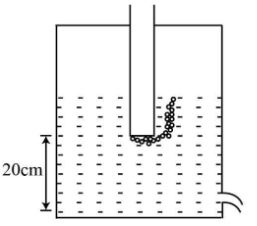Question
Question: A tube is attached as shown in a closed vessel containing water. The velocity of water coming out fr...
A tube is attached as shown in a closed vessel containing water. The velocity of water coming out from a small hole is

A.2m/s
B.2m/s
C. Depends on the pressure of the air inside the vessel
D. none of these
Solution
This problem can be solved using the concept of Bernoulli’s theorem. Bernoulli's theorem states that "The decrease in the pressure (or potential energy) of a fluid is the effect of the increase in its speed." that is, the reduction in the pressure of fluid occurs when that fluid speeds up.
Formula used:
P1+21ρv12+ρgh1=P2+21ρv22+ρgh2
Complete answer:
From given, we have,
The height of the water level = 20 cm
Therefore, the height = 0.2 m
The velocity of water coming out from a small hole, v2= ?
The pressure at the bottom of the tube inserted in a closed vessel is equal to the pressure at a small hole present at the bottom of the closed vessel.
Let the velocity of the water at the bottom of the test tube be v1
Let the velocity of the water at the small hole of the closed vessel be v2
The velocity v1 is so small that it can be considered to be equal to zero.
We use Bernoulli’s theorem to solve this problem. Bernoulli’s equation is given by,
Energy per unit volume before = Energy per unit volume after
P1+21ρv12+ρgh1=P2+21ρv22+ρgh2
Where Pis the pressure energy, 21ρv2is the kinetic energy per unit volume and ρghis the potential energy per unit volume.
As the position of the small hole is at the bottom, thus the height is considered to be zero.
From given conditions, we have,
P1=P2, h2=0and v1=0
Substitute these values in the above equation.
